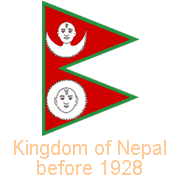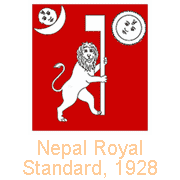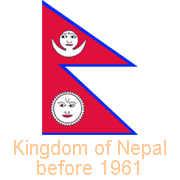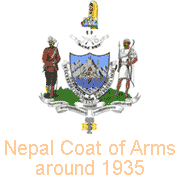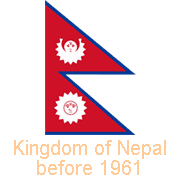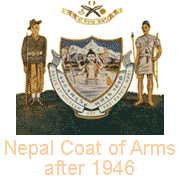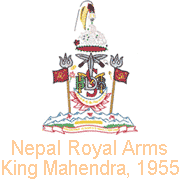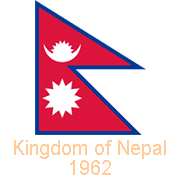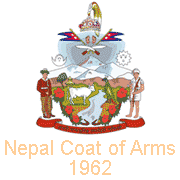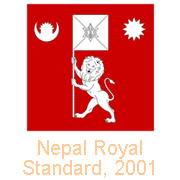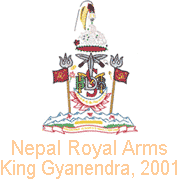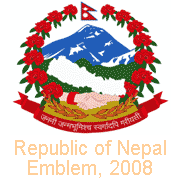Flags from Nepal
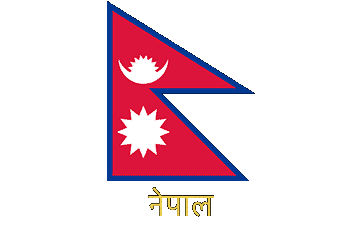
A Flag history of Nepal
Nepal is the only country in modern times with a non-rectangular flag, a combination of two pennons or pennants, overlapping right triangles. The smaller upper triangle displays a stylised moon, symbolising the king, and the larger lower triangle shows the sun, symbolising the Rana family, members of which acted as prime ministers until 1961. The flag’s colour is crimson red, the national colour, a symbol of bravery; the border is blue, the colour of peace.
you may then send it as a postcard if you wish.
The Kingdom of Nepal was established when Prithvi Narayan Shah unified all small principalities in 1769. In those days, all flags on the Indian subcontinent were triangular. After 1850, the hereditary Rana Prime Ministers ruled the country, and a flag was adopted that combined two red crimson pennants that belonged to rival branches of the Rana dynasty. The moon and sun symbols both showed a “tilak”, the sign of Vishnu, on the forehead and the flag’s border was green at first. Over the years, the flag’s design became two overlapping right triangles, but the sun and moon symbols could look different, as it was not an official flag, and the shape was not standardised.
On 16 December 1962, after the power of the Rana Prime Ministers had been broken, King Mahendra established a constitutional form of government, the flag was modernised, and the facial features in the symbols were removed. The flag became official and was standardised, displaying a white stylised moon and a twelve-pointed sun, expressing the hope that Nepal will live as long as the Sun and the Moon. Also, the moon represents the Nepali people’s calm demeanour and purity of spirit, while the sun represents their fierce resolve. The moon also symbolises the cool weather of the Himalayas, whereas the sun symbolises the heat and the high temperature of the Terai, the Nepali lowlands. With the abolition of the monarchy, the two triangles now represent Hinduism and Buddhism, the country’s main religions.
The Nepali Royal Standard was an almost square white-bordered crimson flag. It featured, in white, a lion bearing a white flag, initially plain white but later displaying black diagonals and a black circle in the centre. The last Royal Standard, used by King Gyanendra, is displayed on the banner of the lion instead of a circle, a Magen David-type star, and a vertical sword. Both are royal symbols, standing respectively for knowledge and strength. The moon and sun symbols from the flag were displayed in the upper corners, initially showing the faces, but they were removed after 1962. The kings also had royal arms from the Shah dynasty, displaying their initials, while the last king, Gyanendra, employed the Magen David-type star and vertical sword.
Nepal’s Coat of Arms until 1962 showed, on a shield, the peak of the Himalayas and the Hindu god Vishnu. Two Gurkha soldiers flank the shield: one carries a rifle, the other a bow and arrow. Above this are two crossed “Kukris”, associated with the Gurkhas, the moon and sun symbols and the footprints of Gorakhnath, the guardian deity of the Gurkhas. Framing the shield was a motto in Sanskrit and Latin, “Dulce et decorum est pro patria mori” (It is sweet and honourable to die for your country). The Arms changed in 1962 and displayed a white cow, a green pheasant (the Himalayan monal, Lophophorus impejanus) and the Rhododendron, Nepal’s national flower. At the base was a red scroll with the national motto in Sanskrit, meaning “Mother and Motherland are greater than heaven”.
After the abolition of the monarchy, the flag was not changed, but a new emblem of the Federal Democratic Republic of Nepal was introduced on 28 May 2008. It now displays Mount Everest, the green hills symbolising the hilly regions of Nepal and yellow at the bottom, signifying the fertile Terai region. A garland of Rhododendron, the national flower, and clasped male and female hands, expressing gender equality, surround it. Overlaid on it is a white silhouette in the shape of Nepal. It is surmounted by a Nepalese flag, and at the base is a red scroll with the national motto in Sanskrit: “Jananī janmabhūmiśca svargādapi garīyasī” (Mother and Motherland are greater than heaven).


